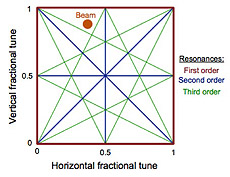Accelerator tunes
 |
| This diagram shows the so-called tune space for an accelerated particle beam. The colored lines indicate resonances in tune space to be avoided. The dot represents a possible stable area where neither horizontal nor vertical tunes are near a line. |
In my last column, we concluded that circular accelerators that pass charged particles through a set of accelerating cavities many times is an effective strategy for achieving high energies. However, maintaining a beam while it makes many passes around the accelerator is not as simple as it may seem.
The first problem arises because the beam has a tendency to spread and will do so very quickly, becoming too large for the vacuum chamber unless we employ a mechanism to focus it. To solve the problem, quadrupole magnets, which focus the beam, are inserted at regularly spaced intervals between the bending magnets in the accelerator. Two quadrupole magnets at each location are required to focus the beam simultaneously in the horizontal and vertical planes. The result is a beam that oscillates in height and width as it circumnavigates the accelerator ring.
The number of oscillations the beam makes on each pass around the accelerator is called the tune. If we could make perfect magnets, our job would be done. However, the outstanding staff in Technical Division simply cannot make a perfect magnet.
To illustrate the problem caused by an imperfect magnet, imagine a particle going around the machine many times and passing through the magnets in the same position each time. Suppose it experiences a tiny error in the field on each pass that causes a horizontal displacement error in the beam of one millimeter. Imagine the particle is in the Main Injector, where each beam particle makes almost 100,000 trips around the accelerator each second. The additive one-millimeter error would result in a net displacement for the beam particle of almost 100 meters in one second, which means the particle would be lost in much less than a second.
To keep the beam in the accelerator, we must make certain that the particle does not see the same error each time it passes around the machine. We can do this by adjusting the tune so that the number of oscillations each particle makes per orbit is not an integer. The result is that the particle takes a different path each time around.
However, this adjustment is still not good enough. Taking the same path every other time or every fourth time (and so on) is also a problem. Problem tunes such as these are called resonances, and they must be avoided as much as possible to achieve stable beam. The tune space available for stable running is remarkably small.
Nevertheless, resonances are not all bad. They can be used to slowly extract beam from an accelerator by gradually moving the tune toward a resonance using a focusing magnet tied to a feedback system. Changing the tune in this manner causes the beam to stream smoothly toward an exit channel, where an electric field deflects it, allowing it to be extracted to a beamline.
Now you know the tunes that the accelerator operators play. They are catchy.
—Roger Dixon
Want a phrase defined? Have a question? Email today@fnal.gov.
|